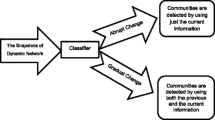Abstract
Dynamic complex social network is always mixed with noisy data and abnormal events always influence the network. It is important to track dynamic community evolution and discover the abnormal events for understanding real world. In this paper, we propose a novel algorithm Noise-Tolerance Community Detection (NTCD) to discover dynamic community structure that is based on historical information and current information. An updated algorithm is introduced to help find the community structure snapshot at each time step. One evaluation method based on structure and connection degree is proposed to measure the community similarity. Based on this evaluation, the latent community evolution can be tracked and abnormal events can be gotten. Experiments on different real datasets show that NTCD not only eliminates the influence of noisy data but also discovers the real community structure and abnormal events.



Similar content being viewed by others
References
Asur S, Parthasarathy S, Ucar D (2007) An event-based framework for characterizing the evolutionary behavior of interaction graphs. In: Proceedings of the 13th ACM SIGKDD Conference
Blondel VD, Guillaume JL, Lambiotte R, Lefebvre E (2008) Fast unfolding of communities in large networks. J Stat Mech P10008
Chakrabarti D, Kumar R, Tomkins A (2006) Evolutionary clustering. In: Proceedings of the 12th ACM SIGKDD Conference
Chi Y, Song X, Zhou D, Hino K, Tseng BL (2007) Evolutionary spectral clustering by incorporating temporal smoothness. In: Proceedings of the 13th ACM SIGKDD Conference
Danon L, Duch L, Guilera AD, Arenas A (2005) Comparing community structure identification. J Stat Mech 9:P09008
Falkowski T, Bartelheimer J, Spiliopoulou M (2006) Mining and visualizing the evolution of subgroups in social networks. In: IEEE/WIC/ACM WI
Fortunato S (2010) Community detection in graphs [J]. Phys Rep 486(3–5):75–174
Gomez-Rodriguez M, Leskovec J (2013) Structure and dynamics of Info. pathways in online media, WSDM
Kumar R, Novak J, Raghavan P, Tomkins A (2003) On the bursty evolution of blogspace. In: Proceedings of the 12th WWW Conference
Kumar R, Novak J, Tomkins A (2006) Structure and evolution of online social networks. In: SIGKDD
Lancichinetti A, Radicchi F, Ramasco JJ, Fortunato S (2011) Finding statistically significant communities in networks. PLoS One 6:e18961
Leskovec J, Kleinberg J, Faloutos C (2005) Graphs over time: desification laws, shrinking diameters and possible explanations. In: SIGKDD
Leskovec J, Kleinberg J, Faloutsos C (2005) Graphs over time: densification laws, shrinking diameters and possible explanations. In: Proceedings of the 11th ACM SIGKDD Conference
Leskovec J, Lang KJ, Dasgupta A, Mahoney MW (2008) Statistical properties of commu-nity structure in large social and information networks. In: ACM WWW
Lin YR, Chi Y, Zhu S, Sundaram H, Tseng BL (2008) Facetnet: a framework for analyzing communities and their evolutions in dynamic networks. WWW ’08: Proceeding of the 17th international conference on World Wide WebNew York, NY. ACM p, USA, pp 685–694
Mei Q, Zhai C (2005) Discovering evolutionary theme patterns from text: an exploration of temporal text mining. In: Proceedings of the 11th ACM SIGKDD Conference
Newman MEJ (2004) Detecting community structure in networks. Eur Phys J B 38(2):321–330
Nguyen NP, Dinh TN, Tokala S, Thai MT (2011) Overlapping communities in dynamic networks: their detection and mobile applications. In MobiCom ’11: Proceedings of the 17th annual international conference on mobile computing and networking, pp 85–96
Palla G, Barabasi AL, Vicsek T (2007) Quantifying social group evolution. Nature 446:664–667
Sarkar P, Moore AW (2005) Dynamic social network analysis using latent space models. SIGKDD Explor. Newsl. 7(2)
Spiliopoulou M, Ntoutsi I, Theodoridis Y, Schult R (2006) Monic: modeling and monitor-ing cluster transitions. In: Proceedings of the 12th ACM SIGKDD Conference
Sun J, Faloutsos C, Papadimitriou S, Yu PS (2007) GraphScope: parameter-free mining of large time-evolving graphs. In: Proceedings of the 13th ACM SIGKDD Conference
Tang L, Liu H, Zhang J, Nazeri Z (2008) Community evolution in dynamic multi-mode networks. In: Proceeding of the 14th ACM SIGKDD international conference on Knowledge discovery and data mining Las Vegas, Nevada, USA, pp 677–685
Tantipathananandh C, Berger-Wolf T, David Kempe A (2007) Framework for community identification in dynamic social networks. KDD, august. California, USA, pp 717–726
Toyoda M, Kitsuregawa M, (2003) Extracting evolution of web communities from a series of web archives. In HYPERTEXT 03: Proceedings of the 14th ACM conference on hypertext and hypermedia
Wang L (2011) SoFA : an expert-driven, self-organization peer-to-peer semantic communities for network resource management. Expert Syst Appl 38(1):94–105
Wang L, Wang J, Shen H-W, Cheng X-Q (2013) Improvement on fast uncovering community algorithm. Chinese phys B 22(10):108903. doi:10.1088/1674-1056/22/10/108903
Zhao Q, Bhowmick SS, Zheng X, Kai Y (2008) Characterizing and predicting community members from evolutionary and heterogeneous networks. In: Proceeding of the 17th ACM conference on Information and knowledge management. Napa Valley, California, USA, pp 309–318
Acknowledgments
Partially supported by the Major State Basic Research Development Program of China (Grant No. 2013CB329602), the International Collaborative Project of Shanxi Province, China (Grant No. 2011081034), the National Natural Science Foundation of China (Grant No. 61202215, 61100175, 61232010). China postdoctoral funding (Grant No. 2013M530738).
Author information
Authors and Affiliations
Corresponding author
Rights and permissions
About this article
Cite this article
Wang, L., Wang, J., Bi, Y. et al. Noise-tolerance community detection and evolution in dynamic social networks. J Comb Optim 28, 600–612 (2014). https://doi.org/10.1007/s10878-014-9719-z
Published:
Issue Date:
DOI: https://doi.org/10.1007/s10878-014-9719-z




